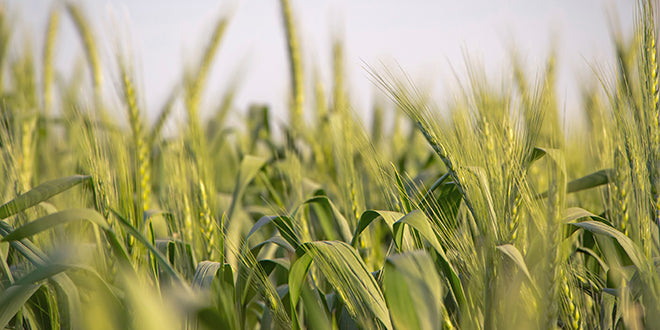The most important food I consume each day is my BarleyMax. This green drink from the dehydrated juice powders of barley and alfalfa leaves is the most nutritionally dense food I am aware of. This is precisely why it is the first thing I introduce into my body.
Why do I have such a high regard for BarleyMax?
I was introduced to green drinks when I spent some time at the Hippocrates Institute in Boston, Massachusetts with Dr. Ann Wigmore in the late 1970’s. She was growing wheat grass on cafeteria trays. It was truly a learning experience and one I will never forget. Her kitchen was the first kitchen I had ever seen without a stove.
There were a number of us learning and experiencing how to grow living foods (both sprouts and wheat grass) indoors. We would harvest the grass from the trays several times each day and run it through a juicer. I must confess I did not find the taste of the freshly extracted wheat juice appealing. However, Dr. Ann said it was good for me, so I drank it.
I came home, purchased some cafeteria trays, some potting soil, some wheat seeds, a juicer, and started growing wheat grass in my windows. I harvested the grass and ran it through my newly purchased, hand-cranked juicing machine. I drank that not-so-pleasant-tasting green juice each day.
What’s wrong with growing wheat in cafeteria trays?
Through the years following that first experience with wheat grass, I have been doing a lot of research and experimenting on how to best grow grasses for juicing. I have learned a lot.
Following are a few of the reasons I have found as to why growing wheat grass in cafeteria trays is the least desirable way to grow it:
- The amount of nutrients available to the root of the growing seed is limited to the nutrients contained within the seed itself along with the nutrients found in the inch of soil it’s growing in.
- Sprouting takes place too rapidly and is ready for harvesting in just 10-14 days. This does not allow enough time for the plant to develop a significant root system. Due to the limited about of soil it is growing in there is a very limited about of nutrients available to the roots.
- Shoots mature too rapidly in the warm indoor atmosphere, resulting in a simple carbohydrate makeup rather than a complex carbohydrate. Simple carbohydrates convert to sugar very rapidly and are in the least desirable form to receive them.
"Tray grown grass, grown indoors, never achieves the jointing stage when most of the vitamins and protein reach their peak.” Also, “because it grows so quickly under warm conditions, the plant has a relatively high level of simple sugars. . . The warm temperatures and low air circulation also cause growing problems. Mold is the scourge of all indoor growers and that is because grass likes it cool... The accelerated growth causes the indoor plant to put most of its energy into growing leaves rather than roots. Thus very few minerals can be absorbed from the roots and utilized to produce more complex nutrients... The soil in trays is only 1-2 inches deep and the roots are barely mature enough to assimilate nutrients no matter how good the soil. "In contrast, outdoor grass develops deep roots, pulling up minerals and manufacturing vitamins over 60-200 days of slow growth... Sun beats down on the field crop for weeks (longer for winter wheat). Such exposure and slow growth in the cool fall or spring turns the grass into a solar collector storing high concentrations of energy in its leaves. This provides a full spectrum of chlorophyll, trace minerals and micro-nutrients. This is how wheat was designed to grow. "In nature, the purpose of the plant is to produce grain. Once it has accumulated enough solar energy/nutrition, it generates the wheat berries which we collect and grind into flour. By harvesting the plant just before it joints, we are taking advantage of the ‘vegetable at its nutritional prime. Although we can grow it indoors... the finest wheat and barley grass is grown outdoors."Advantages of growing in the ground and outdoors Common sense and nature tell us that growing in the ground outdoors is the way God designed our food to grow. There are a number of reasons why growing cereal grasses outdoors is superior to growing them indoors.
- Grown in deep mineral and nutrient dense soil provides a huge reservoir from which the roots can draw nutrients, rather than being limited to an inch of soil in a cafeteria tray.
- When planted in the fall, the seeds develop roots throughout the fall, winter, and spring, extracting a broad range of nutrients.
- Shoots develop very slowly in the cool fall, winter, and spring seasons. This produces a much more complex carbohydrate which the body handles much better than the simple carbohydrate found in the cafeteria tray-grown grass.
- Grass is harvested at the peak of nutrition, just prior to the jointing stage at which time the grass is preparing to produce the grain. Once the grain starts to form, nutrient density in the leaf drops significantly.
- Since the grass is harvested prior to the jointing stage it contains no gluten (gluten is found only in the grain or seed of the plant).
- Organic barley and alfalfa seed sown in the fall and grown throughout the fall, winter, and early spring months allows the roots to have an extended growing time to absorb maximum nutrients from the soil into the leaf.
- Twenty percent of BarleyMax is dehydrated alfalfa juice powder. Alfalfa has the deepest root system of all the grasses. It has the ability to send roots as deep as 100 feet into the soil to extract maximum nutrients and place them into the leaf.
- It is grown at an elevation of 5,000 feet in the Rocky Mountains in an old volcanic lakebed. The plants are watered with deep, mineral-rich well water, and harvested just before jointing. (Previous volcanic activity leaves huge amounts of trace minerals in the soil from which the roots can draw nutrients. Most soils in the United States do not have this advantage.)
- After harvesting, the barley and alfalfa leaves are immediately transported to a facility for washing (using no harsh sanitizers or heat), then juiced and dehydrated. The grasses used in BarleyMax are harvested, juiced, and dried all within a few hours of harvesting.
- Unlike BarleyMax, many other barley juice powder producers reduce the juice to a powder using significant heat. This heat destabilizes the enzymes, requiring stabilizers such as maltodextrin and brown rice.
- BarleyMax is dried using a patented process of dehydration that reduces the juice to a powder at just 98 degrees. Because enzymes do not begin to break down until the temperature reaches 107 degrees, the enzymes in BarleyMax are not damaged in the processing.
- Because the enzymes in BarleyMax are not subjected to damaging heat in processing, no stabilizer is needed, thus reducing serving size to one teaspoon to get the equivalent of barley powder found in a tablespoon of the heat damaged product requiring stabilizers. (These stabilizers can sometimes account for over half of the content of products containing maltodextrin and brown rice.)
- Because the leaves used in BarleyMax are not sanitized and the juice has no enzyme destabilizing heat applied in processing, the friendly bacteria in BarleyMax are not damaged nor destroyed.
- When a competitive product boasts that its bacteria count is less than that of BarleyMax, it is because the product has had heat applied in processing which has wiped out much of the friendly bacteria. BarleyMax is constantly checked for unfriendly bacteria.
- BarleyMax contains no fiber, thus it is 100% juice powder. Some barley powders contain the ground up leaf, thus much of the product is fiber. (You can determine if a product has fiber by stirring a serving into eight ounces of water and observing. BarleyMax remains clear, while many brands have fiber floating or on bottom or both.) This fiber serves as a filler, not to mention that it interferes with the body's ability to efficiently absorb the juice.
- BarleyMax comes in three flavors – original, berry, and mint. All flavorings are naturally derived. The most popular remains the “original,” but new users usually prefer the “berry.”
- Cost per serving is only 33 cents. The 8.5 ounce size container provides 120 teaspoon servings at just $39.95 per container. If consumed at the suggested rate of three servings a day, the cost is just 99 cents per day. When compared to the cost per serving of other products on the market, you can appreciate BarleyMax’s outstanding value.
- Where else can you get an exceptionally pure, one-of-a-kind super food for just 99 cents a day? Superior nutrition doesn’t have to be expensive – in fact, BarleyMax is arguably the best value for the best quality, live enzyme juice powder on the market.







